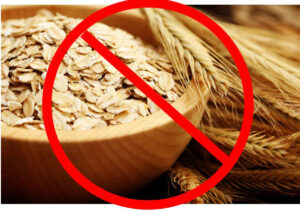What Does This Study Mean For You?
Author: Dr. Stephen Chaney
 If you are gluten sensitive like me, grains that have taste, texture, and fiber are few. Oatmeal is one of my favorites. In fact, I start every day with a bowl of oatmeal. So, when I first saw the headlines suggesting that oats might be bad for me because they might be contaminated with a toxic chemical, my first reaction was, “Say it isn’t so”.
If you are gluten sensitive like me, grains that have taste, texture, and fiber are few. Oatmeal is one of my favorites. In fact, I start every day with a bowl of oatmeal. So, when I first saw the headlines suggesting that oats might be bad for me because they might be contaminated with a toxic chemical, my first reaction was, “Say it isn’t so”.
Naturally, I did some research on the subject and looked up the study (AM Temkin et al, Journal of Exposure Science & Environmental Epidemiology, published February 15, 2024) behind the headlines.
The study documented the presence of a potentially toxic agricultural chemical called chlormequat found in our food supply and in our urine. If you are like me, you have probably never heard of chlormequat before, so a little explanation is in order.
What Is Clormequat?
 Chlormequat is an agricultural chemical that is widely used on oat, barley, and wheat crops in Europe and Canada. It is not a pesticide or herbicide. It does not enhance the nutritional value of the grains it is sprayed on.
Chlormequat is an agricultural chemical that is widely used on oat, barley, and wheat crops in Europe and Canada. It is not a pesticide or herbicide. It does not enhance the nutritional value of the grains it is sprayed on.
It is a growth regulator. Its sole role is to decrease the stem height of these crops and prevent them from bending over, so that mechanical harvesting of the crops is more efficient. It is a perfect example of the industrialization of modern agriculture.
No human studies have been done on clormequat, but animal studies suggest it may affect fertility, harm the reproductive system, and lead to altered fetal growth and development.
The US Environmental Protection Agency:
- First allowed the import of clormequat in oat, wheat, and barley imported into the United States in 2018.
- Increased the allowable amount of chlormequat on imported oats in 2020.
- Is currently considering allowing the use of chlormequat on oats, barley, and wheat grown in the United States.
How Was This Study Done?
 Urine samples were collected from US adults from three geographical regions between 2017 and 2023.
Urine samples were collected from US adults from three geographical regions between 2017 and 2023.
- 21 urine samples from Charleston, South Carolina in 2017.
- 25 urine samples from between October 2017 and September 2022 from Maryland Heights, Missouri.
- 50 urine samples from Florida in 2023.
All the urine samples were analyzed for chlormequat by LC MS/MS.
Food samples (25 conventional and 8 organic oat products and 9 conventional wheat products) were purchased from US grocery stores in the Washington DC area between June 2022 and May 2023 and analyzed for chlormequat levels by the same method.
Are Oats Bad For You?
 The results of the study were surprising.
The results of the study were surprising.
- Overall chlormequat was detected in 80 % of the urine samples. Moreover, the trend was concerning. Clormequat was detected in:
-
- 69% of the urine samples collected in 2017.
-
- 74% of the urine samples collected between 2018 and 2022.
-
- 90% of the urine samples collected in 2023.
- The average level of chlormequat detected in the urine in 2023 was 3 times higher than in previous years.
The authors speculated that the large increase of chlormequat in the urine of US citizens in 2023 represented the time it took for chlormequat-contaminated grains to work their way into the US food supply after the EPA increased the amount of allowable chlormequat in imported grains in 2020.
When the investigators measured chlormequat contamination in foods derived from oats and wheat in 2022 and 2023 they found chlormequat contamination in:
- 92% (23 out of 25) conventional oat-based products. This included popular brands such as Quaker Oatmeal and Cheerios.
- 5% (1 out of 8) organic oat-based products.
- 22% (2 of 9) conventional wheat-based products. The level of chlormequat contamination was also around 10-fold lower in wheat-based products than in oat-based products.
The authors concluded. “This study reports the detection of chlormequat, an agricultural chemical with developmental and reproductive toxicity, in the U.S. population and the U.S. food supplies for the first time…This work highlights the need for more expansive monitoring of chlormequat in U.S. foods and in human specimens, as well as toxicological and epidemiological study on chlormequat, as this chemical is an emerging contaminant with documented low-dose adverse health effects in animal studies.”
What Does This Study Mean For You?
 It would be easy to dismiss this study, and the headlines that go with it, as alarmist.
It would be easy to dismiss this study, and the headlines that go with it, as alarmist.
- The toxic effects of chlormequat on the reproductive system have only been seen in a handful of animal studies. There are no human studies correlating levels of chlormequat in the body with reproductive issues or other health outcomes.
- The chlormequat levels seen in urine in this study were far below the minimum thresholds published by the US EPA and the European Food Safety Authority.
However, this is a troubling component of a much larger pattern.
- Currently, there are over 3,000 chemicals in our food supply that have not been tested for safety by the FDA. Chlormequat is just the latest addition to the list.
- One recent study identified over 700 potentially toxic chemicals in human blood.
- Another study found over 200 potentially toxic chemicals in newborn umbilical cord blood.
This is a witch’s brew of chemicals. While most of these chemicals in our blood are far below the minimum levels set by the EPA, nobody has studied how they interact with each other. In short, the danger for each chemical individually may be small, but nobody knows what the cumulative risk is for hundreds of chemicals working together.
So, while we may be able to ignore the current headlines about toxic oats, we should not ignore the larger and growing concern about thousands of untested chemicals in our food supply and hundreds of potentially toxic chemicals in our blood.
My recommendation, of course, is to buy organic whenever possible. For example, my wife purchases our oatmeal at the farmer’s market from a local farmer who grows his oats organically and grinds his own oatmeal.
The Bottom Line
You may have seen recent headlines saying that oats are bad for you, because they might be contaminated with a toxic chemical.
In the article above I review the study behind the headlines and put it into perspective for you.
For more details about the study and what it means for you, read the article above.
These statements have not been evaluated by the Food and Drug Administration. This information is not intended to diagnose, treat, cure, or prevent any disease.
______________________________________________________________________________
My posts and “Health Tips From the Professor” articles carefully avoid claims about any brand of supplement or manufacturer of supplements. However, I am often asked by representatives of supplement companies if they can share them with their customers.
My answer is, “Yes, as long as you share only the article without any additions or alterations. In particular, you should avoid adding any mention of your company or your company’s products. If you were to do that, you could be making what the FTC and FDA consider a “misleading health claim” that could result in legal action against you and the company you represent.
For more detail about FTC regulations for health claims, see this link.
https://www.ftc.gov/business-guidance/resources/health-products-compliance-guidance
_______________________________________________________________________
About The Author
 Dr. Chaney has a BS in Chemistry from Duke University and a PhD in Biochemistry from UCLA. He is Professor Emeritus from the University of North Carolina where he taught biochemistry and nutrition to medical and dental students for 40 years. Dr. Chaney won numerous teaching awards at UNC, including the Academy of Educators “Excellence in Teaching Lifetime Achievement Award”. Dr Chaney also ran an active cancer research program at UNC and published over 100 scientific articles and reviews in peer-reviewed scientific journals. In addition, he authored two chapters on nutrition in one of the leading biochemistry text books for medical students.
Dr. Chaney has a BS in Chemistry from Duke University and a PhD in Biochemistry from UCLA. He is Professor Emeritus from the University of North Carolina where he taught biochemistry and nutrition to medical and dental students for 40 years. Dr. Chaney won numerous teaching awards at UNC, including the Academy of Educators “Excellence in Teaching Lifetime Achievement Award”. Dr Chaney also ran an active cancer research program at UNC and published over 100 scientific articles and reviews in peer-reviewed scientific journals. In addition, he authored two chapters on nutrition in one of the leading biochemistry text books for medical students.
Since retiring from the University of North Carolina, he has been writing a weekly health blog called “Health Tips From the Professor”. He has also written two best-selling books, “Slaying the Food Myths” and “Slaying the Supplement Myths”. And most recently he has created an online lifestyle change course, “Create Your Personal Health Zone”. For more information visit https://chaneyhealth.com.
For the past 45 years Dr. Chaney and his wife Suzanne have been helping people improve their health holistically through a combination of good diet, exercise, weight control and appropriate supplementation.
